SPOILERS AHEAD FOR SPIDER-PUNK #4
The Spider-Band in their Spider-Van has made it to the capital. However, just as they were able to develop their Spider-Plan, they’re getting shut down by the big bad, symbiote-infected, man. Welcome back to the world of Spider-Punk!
The disembodied head of Norman Osborn has revealed himself to the Spider-Punks. The final battle against tyranny is about to commence and it seems to be even more of an uphill battle than first thought. The Osborn administration has received a shot in the arm and is ready to begin another term. Hobie has to fight to make sure Spider-Punk’s last go of it is a good one.
Writer Cody Ziglar, penciller Justin Mason, color artist Jim Charalampidis and letterer VC’s Travis Lanham pit Hobie Brown against the power of the system-given form. The only question that remains is whether or not Spider-Punk can overcome the excess of misery it produces. Although the entire book has been political in its messaging, as is the nature of the punk movement, this issue is the most transparent about it. That’s not to say it’s poorly done, Ziglar makes an interesting point about the nature of martyrdom.
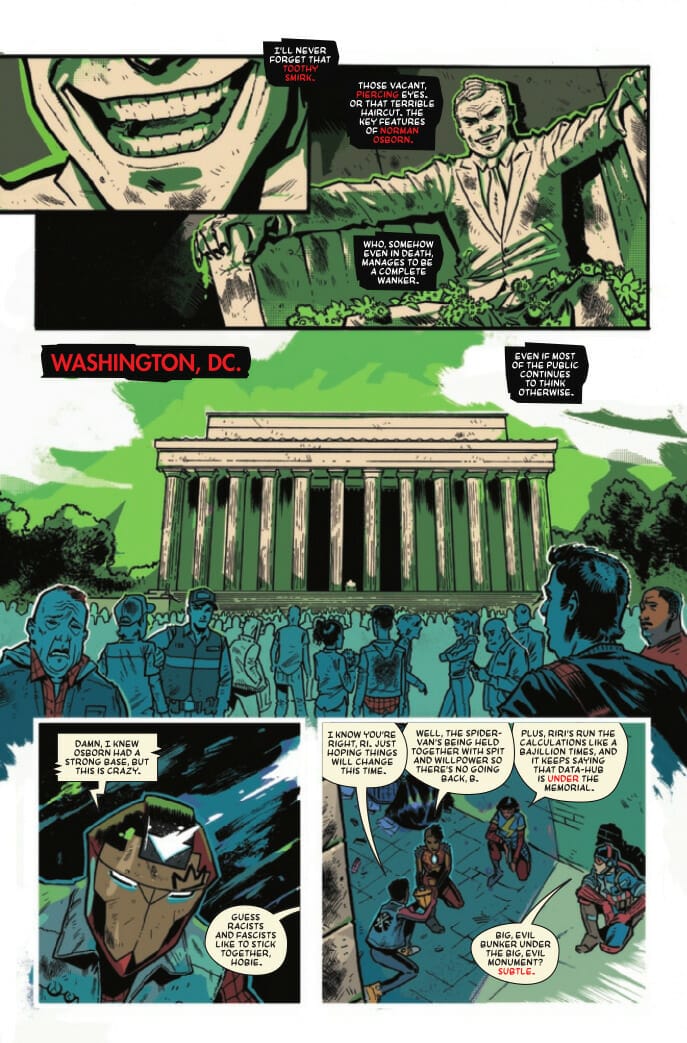
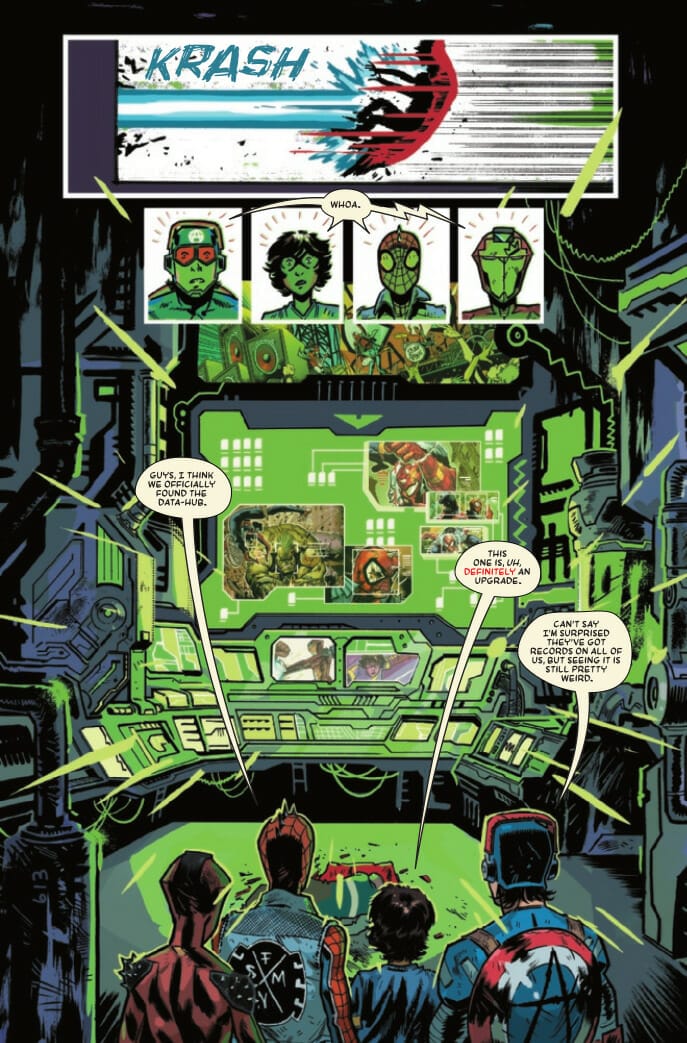
Despite being decapitated at the hands of Spider-Punk, Osborn was able to rally his base and become more popular than ever. He was able to morph himself into representing the fight against anarchy and rampant youth culture. Much like the ‘culture wars’ of 2016, Osborn made his followers focus on the explosive actions taken by his opposition, the Spider-Punks, rather than the reasons behind them. The Spider-Punks, although objectively acting in society’s interests, have been labeled as an enemy of the state and the traitor to the people.
Moreover, Osborn has orchestrated it so that his followers will fight the majority of battles in his stead, again mimicking the ‘culture wars’ that began in 2016 through to now; the Spider-Punks now being an enemy of the people positions Osborn’s fanbase to view them as a threat to their safety rather than a group seeking to usurp the broken system.
Politics aside, this issue also acts as this story’s ‘the dark night of the soul’, seeing the Spider-Punks ambushed and beaten by Osborn and his fellow rogues. The biggest testament to Mason’s pencils is the fact that they’re able to convey the brutality of Osborn’s forces without being violent for the sake of it.
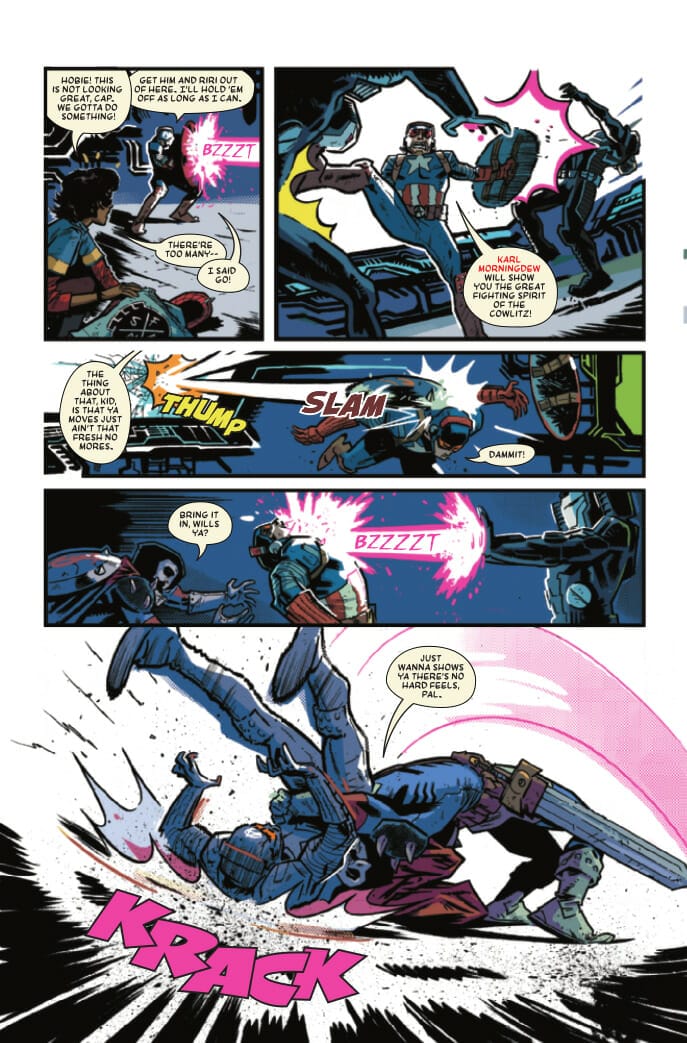
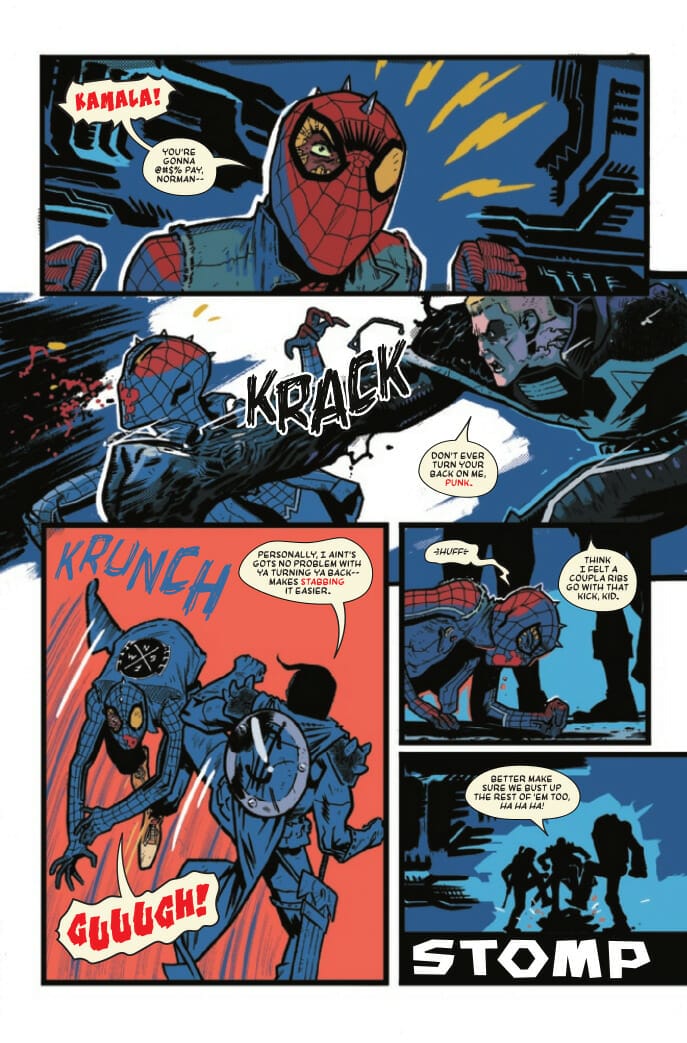
The majority of the ‘violence’ comes from the implementation of onomatopoeias by Lanham. Each significant hit is accompanied by a jagged piece of text conveying the sounds of broken bones, spats of blood, and powerful electric blasts. This use of sound effects allows the reader to still perceive the power behind these attacks without needing the visuals to be overly detailed.
This defeat allows Hobie Brown to have a great scene for his characterization. In issue two of this series, Hobie expressed that their efforts to defeat Osborn were fruitless because he still had the network of underground caches to ensure that the people would still live in fear. He may have cut down the tree but he didn’t entirely uproot it yet.
This issue only furthers this feeling of failure for Hobie. Osborn directly credits his death at the hands of Spider-Punk for his boost in popularity and influence. Although Hobie worked so hard to eradicate Osborn, he empowered him beyond when he was alive. Ultimately he must take responsibility for the support behind Osborn.
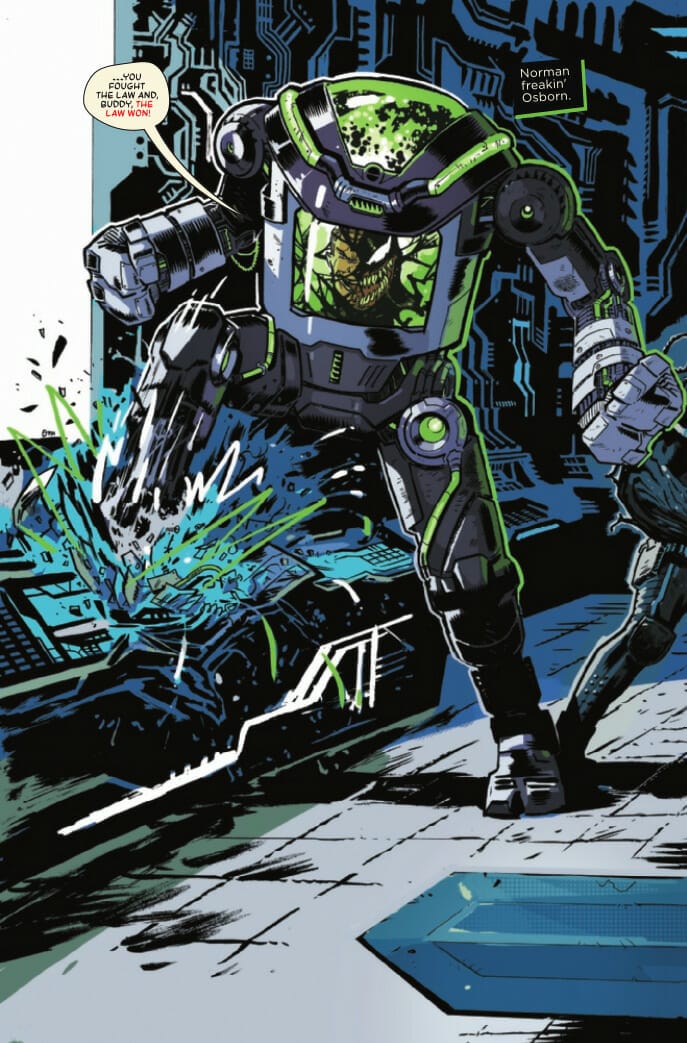

Typical of alternate universe stories, this issue continues to introduce Earth-138 versions of popular Marvel characters. Spider-Punk issue four introduces Officer Venom. Appearing to be Earth-138’s equivalent to Flash Thompson’s Agent Venom, Officer Venom seems to be one of the remaining Venom Cops which Spider-Punk and Captain Anarchy fought against in Spider-Verse #2 (2015).
Alongside Officer Venom, this issue introduces the ‘War Sentry’, a combination between War Machine and the Sentry. Although this character has no dialogue it would be interesting to see how the ‘Void’ personality could be incorporated into this version of the character and how it could service Norman Osborn.
It wouldn’t be a Spider-Punk review if we didn’t gush about Charalampidis’ use of color throughout the issue, most notably the consistent use of green throughout. The capitol is washed in this sickly green tone. Charalampidis’ use of green in this issue works on two levels thematically. The green obviously alludes to Osborn’s iconic alter-ego Green Goblin, implying that he still holds significant influences within the political sphere; this influence is visually showcased by the huge crowd surrounding his monument.
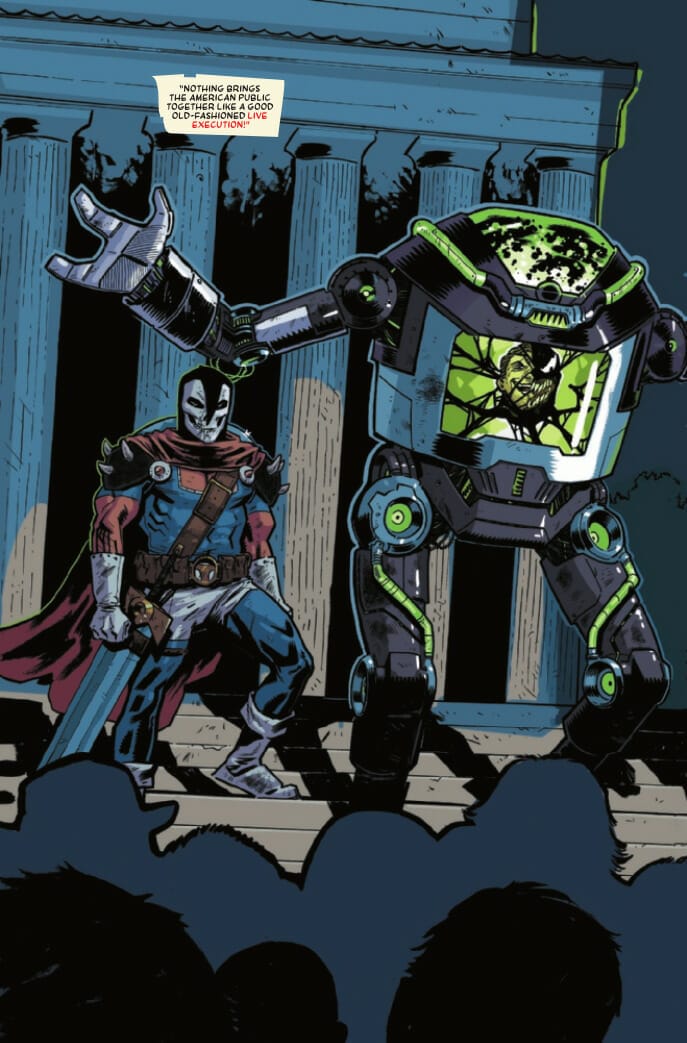
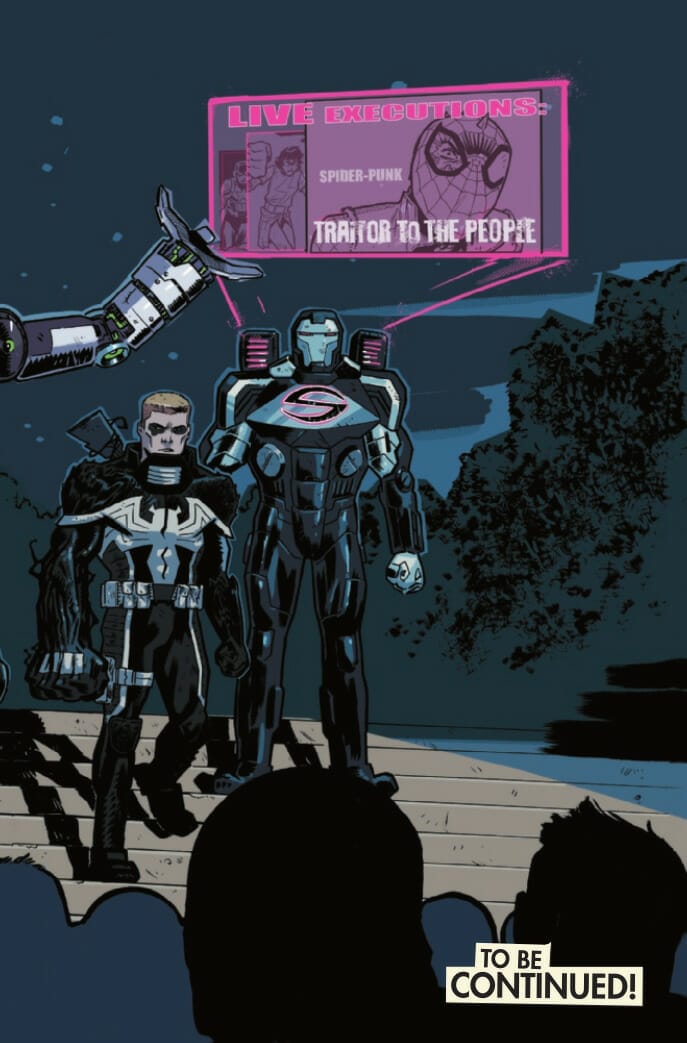
By the same token, the green coloring represents how the United State’s leadership has been poisoned by Osborn’s influence and remains toxic thanks to his newfound martyrdom. Charalampidis’ work on this issue drives home the point that Norman Osborn is the big bad of the piece. The penultimate issue of Spider-Punk defines this series as the battle between freedom of expression & ideology and excessive control & tyranny; the rebels of the punk movement verse the bureaucrats making up fascist government regimes.
Even if some readers don’t care for the politics Ziglar incorporates into this issue, there is still an abundance of fun action scenes and visuals for readers to absorb. Norman Osborn is as villainous as ever and Spider-Punk is still a plucky underdog anyone can root for. Issue four of Spider-Punk, much like the previous entries, offers readers consistently high-quality characters and visuals. With the finale to the book arriving next month, the next issue is set up to possibly be the last act of the Spider-Punks. Fans will need to stay tuned to find out whether or not this will be the Spider-Band’s last hoorah or if there’ll be room for an encore.
Want to discuss things further? Hit us up on Twitter, Facebook, or Instagram. And for more film, gaming, anime, TV news, trailers, and updates keep it locked here at The Nerdy Basement. While you’re here, please consider supporting us on Patreon! It’s easy to support us so we can keep providing you with your Nerdy News!

